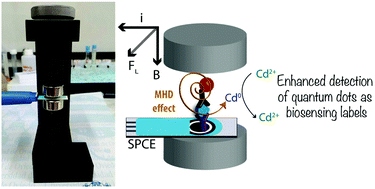Enhanced detection of quantum dots by the magnetohydrodynamic effect for electrochemical biosensing†
Abstract
In this work, we describe the use of a magnetoelectrochemical support for screen-printed electrodes to improve the anodic stripping voltammetry of cadmium due to the generated magnetohydrodynamic (MHD) effect. To create a significant MHD effect, Fe(III) was added at mM concentrations to the solution. The reduction of Fe(III) simultaneously with the cadmium deposition on the electrode surface allowed the production of a high cathodic current, which generated a large Lorentz force capable of exerting a convective effect on the solution in the presence of the magnetic field. This convective effect allowed the increase in the mass transfer in the quiescent solution, enhancing the deposition of cadmium as observed by an increased stripping peak current. The optimized method was applied to the detection of CdSe/ZnS quantum dots (QDs) in solution. Using the magnetoelectrochemical support, we were able to detect extremely low concentrations of QDs, with a detection limit of 100 amol of QDs (in particle number). The great performance shown by this system was evaluated in biosensing applications. Firstly, detection of biotin was carried out using a competitive bioassay between biotin and QD-labelled biotin, obtaining good analytical results (0.6 × 10−10 M as the limit of detection). Then, the magnetoelectrochemical support was tested in a more complex biosensor for the determination of anti-transglutaminase IgA antibodies, a celiac disease biomarker. This work shows that the improvement in the metal electrodeposition caused by the MHD effect can be used successfully for the development of disposable electrochemical biosensors with great performance using screen-printed electrodes.



 Please wait while we load your content...
Please wait while we load your content...